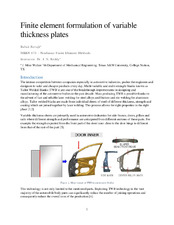Finite element formulation of variable thickness plates
| dc.creator | Ravaji, Babak | |
| dc.date.accessioned | 2019-08-11T23:34:42Z | |
| dc.date.available | 2019-08-11T23:34:42Z | |
| dc.date.issued | 2019-08-11 | |
| dc.identifier.uri | https://hdl.handle.net/1969.1/177751 | |
| dc.description.abstract | The intense competition between companies especially in automotive industries, pushes the engineers and designers to safer and cheaper products every day. Multi-variable and multi-strength blanks known as Tailor Welded Blanks (TWB’s) are one of the breakthrough improvements in designing and manufacturing of the automotive bodies in the past decade. Mass producing TWB is possible thanks to the advent of fast and reliable laser welding for steel alloys and friction and stir welding for aluminum alloys. Tailor welded blanks are made from individual sheets of steel of different thickness, strength and coating which are joined together by laser welding. This process allows for right properties in the right place. In this report the governing equations of the first-order shear deformation theory for plates and its application via finite element method in addition to the capability of modeling variable thickness plate is studied. | en |
| dc.language.iso | en_US | |
| dc.rights | CC0 1.0 Universal | en |
| dc.rights.uri | http://creativecommons.org/publicdomain/zero/1.0/ | |
| dc.subject | Finite element method | en |
| dc.subject | plate | en |
| dc.subject | variable thickness | en |
| dc.subject | Tailor Welded Blank | en |
| dc.subject | TWB | en |
| dc.title | Finite element formulation of variable thickness plates | en |
| dc.type | Article | en |
| local.department | Mechanical Engineering | en |
Files in this item
This item appears in the following Collection(s)
-
Graduate and Professional Student Publications and Conference Presentations
This collection may include: articles, conference posters, slides, professional working papers and presentations by graduate and professional students



